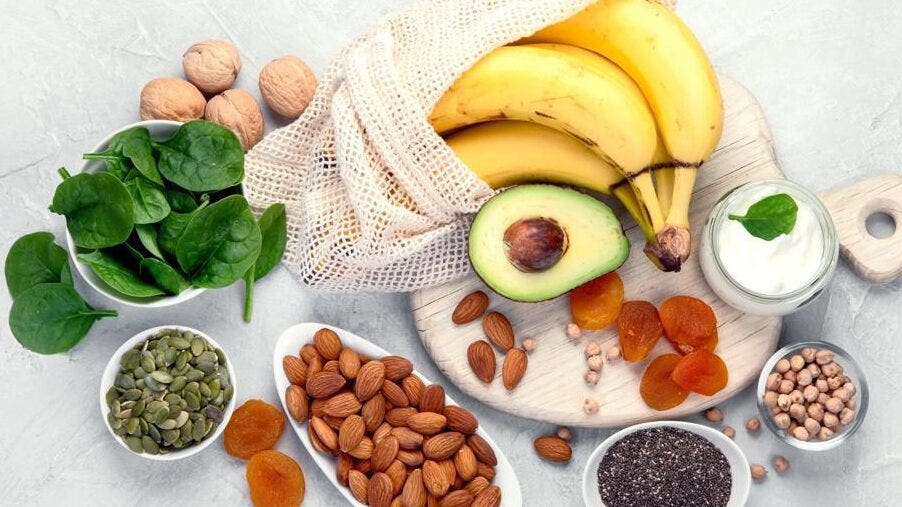Different foods contain varying amounts of magnesium, and some are easier and more practical to incorporate into a daily diet than others. Here’s a look at some of the foods that are considered magnesium-rich and easy to add to your next meal, according to Dr. Maples and Dr. Minich.
Pumpkin seeds
Out of all the magnesium-rich foods, pumpkin seeds contain some of the highest levels of magnesium, according to the NIH. Raw pumpkin seeds, or pepitas, boast a whopping 500 milligrams of magnesium per 100 grams. They contain a number of other minerals as well, including potassium, phosphorus and zinc. In fact, the American Heart Association reports that a single serving of pumpkin seeds contains nearly half the recommended daily intake of zinc.
To incorporate pumpkin seeds into a daily diet, include in a handful as a snack or sprinkle them on top of a salad, a bowl of soup or add them to baked goods.
Chia seeds
A portion of chia seeds, which is 1 ounce, contains 95 milligrams of magnesium. These tiny seeds are also a notable source of fiber, calcium, phosphorus and potassium. There are a number of ways to incorporate chia seeds into a well-balanced diet, including sprinkling them on top of yogurt, salads or cereal, combining them in muffin or bread batter and other baked good recipes as an egg replacement, or adding a tablespoon of seeds to a smoothie.
Almonds
Almonds are another food that offers a notable amount of magnesium, according to Dr. Minich. Whole raw almonds contain 258 milligrams of magnesium per 100 grams. These nuts are also a notable source of Vitamin E, monounsaturated fats, fiber, biotin, various minerals and antioxidants. Almonds can be consumed on their own, as almond butter spread on apple slices or a piece of toast, or by using almond flour in lieu of an all-purpose flour when baking or if breading meat, such as chicken or fish.
Spinach
Spinach offers approximately 93 milligrams of magnesium per 100 grams. Alongside magnesium, spinach is also rich in nutrients like Vitamin A, Vitamin K and folate, among others. There are a number of ways to consume this leafy green, including on sandwiches in lieu of lettuce, in soups, casseroles or lasagna, or sauteed with garlic and other veggies.
Cashews
Cashews are another nut that contains magnesium. A serving of 100 grams of raw cashew nuts offers 251 milligrams of magnesium, alongside other nutrients like copper and manganese, protein and fat. While cashews contain saturated fat, this mostly comes from stearic acid, which is believed to have a neutralizing effect on blood cholesterol.
Cashews can be eaten by the handful as a crunchy alternative like chips, says Dr. Maples, as well as in the form of cashew butter or blended to make sauces or cream-like replacements in vegan cooking.
Black beans
Every 100 grams of dried black beans contain 180 milligrams of magnesium. This variety of bean also packs fiber, iron, potassium, phosphorus and other nutrients. Plus, there’s a large range of ways to prepare them, such as in soups and chilis, tacos or burritos or salads and side dishes like beans and rice. It’s even possible to incorporate them into baked goods like brownies and cookies.
Peanut butter
Peanut butter contains 193 milligrams of magnesium per 100 grams, making it an ample source of magnesium, according to Dr. Minich. While peanut butter packs a nutritional punch, offering protein, fiber, phosphorus and potassium, it’s important to look out for the potential additions of salt and sugar.
There are endless ways to incorporate peanut butter into a healthy diet including simply eating a spoonful as a snack, slathering it on bread for a sandwich or adding a tablespoon to a smoothie or oatmeal.
Brown rice
Long-grain, unenriched brown rice contains an estimated 115 milligrams of magnesium per 100 grams. Brown rice also offers fiber, certain B vitamins and potassium in higher amounts compared to white rice. Options for adding this grain to your diet include as part of a stir fry or soup, combined with vegetables for a rice bowl or as an ingredient in a veggie burger.
Luckily, for those worried about getting enough magnesium, the mineral is found in natural, whole foods and beverages, according to Dr. Minich. Further, focusing on magnesium consumption isn’t just good for the specific benefits this mineral provides and the bodily functions it supports. “Magnesium-rich foods provide other health benefits, such as dietary fiber, protein, polyphenols and healthy fats like omega-3s,” says Dr. Minich.

